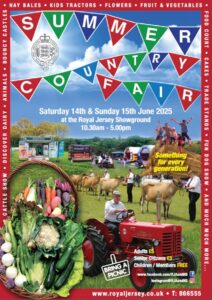
THE Environment Minister, Deputy John Young, has commented on a campaign to stop two fields in St Ouen from being re-zoned within the new Island Plan. It has been proposed to build 77 affordable new homes on the site of Fields Nos O622 and O623. located at the village end of La Route du Marais, bordered by the lane La Rue de la Croute.
One of the fields is used by the last dairy farmer in St Ouen who it is clamed, would have to ‘sell up and cease trading’ if the fields were developed.
In a letter to RURAL magazine, the Minister writes: ‘It is with a heavy heart that I bring forward the development of any fields for the development of homes, but the housing situation is such, that I cannot do otherwise.’
He was commenting on the campaign being coordinated by local residents Robert and Rosemary Blackmore, who had written to all States Members to alert them about the proposals. This was reported on the RURAL website on 10 February: www.ruraljersey.co.uk/more-fields-to-be-re-zoned-for-affordable-homes.
Mrs Blackmore had said: ‘Although we do indeed live very close to the two fields, but this is much more than ” Nimbyism”. We are equally concerned about the other fields threatened with development and the effect of losing viable green zone land in our beautiful parish cannot be underestimated.’
Deputy Young commented: ‘I understand and appreciate the strong views that Mr and Mrs Blackmore may hold in relation to the proposed development. I am aware that they have consistently sought to resist any development on field O622, which has been the subject of previous proposals. Of course, earlier development proposals here will have taken place at a different time and within a different context.
‘As they suggest, field O622 has an extensive planning history and has been reviewed relative to its development potential on a number of occasions. The first of these was in 2010 when a planning application for 19 homes on the site was refused as it represented a departure from the Island Plan at the time. We are now, however, in a different position where the planning policy framework for the new Island Plan is being reset, and we have a significant demand for homes.’
Deputy Young said that unlike previously, a considerable amount of work had been undertaken, not least by the Parish of St Ouen, to identify and assess sites around the village that might best help to meet the need for homes in the parish, while also contributing to the Island-wide need. As a result of their work, a large number of sites, sponsored by those who own them, had been put forward for consideration as part of the Island Plan review.
From this, and additional processes of assessment, those sites considered most appropriate to help meet the need for affordable homes had been brought forward into the draft plan, as originally published back in April last year; and now, as a result of amendment, to help meet an identified housing shortfall.
He continued: ‘In this respect, the draft plan seeks to ensure that most of the Island’s development needs are met within the existing built-up area. In order to meet the express need for affordable homes, however, it is proposed to rezone land to provide 600 affordable homes on greenfield sites: this amounts to about 14% of the overall supply of homes, the remainder being delivered within the Island’s existing built-up areas.
‘The whole process has been independently reviewed by planning inspectors again – as required to do so by law – and, in the case of fields O622 and O623, these fields are considered to offer potential to help meet the Island’s housing needs, relative to others that have been proposed for development.’
The overall assessment of the value of these fields to agriculture had been taken into account in consultation with the Agricultural Land Controls team, in addition to commentary provided by the Jersey Farmers’ Union at the public examination, where their value was recognised and acknowledged by the planning inspectors. Neither field has any agricultural conditions attached to them, and it was appreciated that one is being used by a dairy farmer.
It was recognised that Rue de la Croute is a narrow rural lane and that the development of field O622 – which can only be accessed via Rue de la Croute – was problematic in this respect. Field O623, however, is immediately adjacent to Route du Marais, which affords an opportunity to create direct access to both fields onto the primary road network. Similarly, he said that the impact of any development upon any local ecological interest would need to be the subject of detailed assessment, with appropriate mitigation, as part of any detailed development proposal.
He continued: ‘The fact of the matter is that both fields are in agricultural use and do not enjoy any wildlife designation, and neither does any adjacent land. Although land to the west of the site may be ‘wet’, it is not recognised or indeed designated as a key marshland habitat and does not enjoy any formal designation either, and is not proposed for such. The nearest ecological SSI to the site is in St Ouen’s Bay. Neither does the site suffer from any recognised flood risk.’






4 Responses
Dear Editor ….. I write in SUPPORT of the construction of 77 Affordable Homes.
Your online edition of Rural magazine arrived today, the day after I have returned from a weekend visit to Jersey …. my first visit in 8 years. Having been born in Jersey, grown up in St Ouen and being a cousin of the dairy farmer involved …. the more I read of the proposals, the more it resonated with my background and partial knowledge.
This article has taken me back to my bus journey (no.9a) from Millais to St Helier during the 60’s.
We saw through the bus windows, what then seemed a surprising development of the first houses of St Ouen’s village. My friend was the son of the blacksmith whose forge was obliged to be moved to make way for further houses. It may have surprised some at the time, but with subsequent years the village has, to my knowledge, been welcomed and deemed a Parish asset.
Whilst St Ouen had been one of the first to recognise the need for a Village, I was, some 40 years later, involved with Trinity Parish who had been infamously the last to respond to helping parishioners with either housing for the elderly or young families.
Returning to the fields 0622 and 0623, particularly the latter, in which I believe I even helped …. reluctantly it should be said ….. with potato planting for my Uncle …. possibly in an attempt to buy a Chubby Checker LP …. to provide the musical context of the times.
I would never have known my Uncle’s wishes regarding the future use of his land, but farmers made way in the 60’s to allow the Village to be established, and as I assume there is equivalent land elsewhere, an extension of the Village, particularly for affordable houses, maybe bearing the surname of my Uncle, would be a proud conclusion to this saga.
This land is of agricultural use and would be awful to see it built upon.
Plus the fact it has been rejected 3 times for building.
Why are the many sites with disused greenhouses not being looked at first ?
Look there is no getting away from the fact that there are so many young people desperate to live in their own home, currently renting or house sharing which takes nearly all their income. Lots local born, who happen to have been born at a time when Jersey threw open its doors and said come. Lots of high earners came bought up properties and still do. Bravo to our parishes for trying to put a roof over the heads of young people who would never have a chance else wise. They need it now! There are other fields for the few cattle that enjoy these fields. Priority in this case must be to build these homes as soon as possible.
The writer hits the nail on the head when he says lots o f high earners came in and still do bu6ing up homes that otherwise would be available to local people. That is what the States have to stop not cover more and more green fields with concrete to resolve a problem which they have created by encouraging immigration to generate unsustainable economic activity.